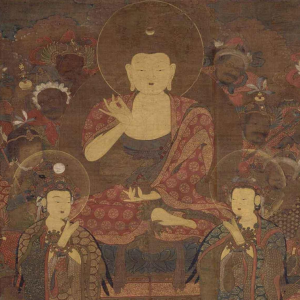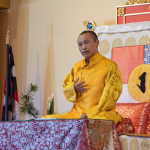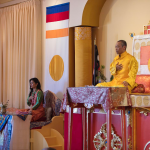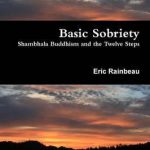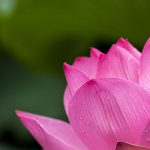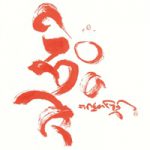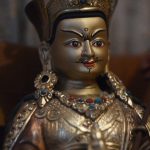Thursday
Dying & Death Classes on Shambhala Online
By Alley Smith

Death is the greatest of all teachers. –The Buddha
Shambhala Online has been offering a variety of courses on topics related to dying and death. These topics enable the sangha and outside community members to gather and think about death, engage in contemplative practices, and toil with topics such as fear, anxiety, the unknown, and how to have conversations about death.
The Shambhala community is gathering with purpose: to understand the dying process, to recognize and articulate the role of spiritual, religious and existential support, practices, and cultural norms within the modern Buddhist context. The result is tremendous openness and courage to face the inevitable and unknown in a gentle and relaxed way.
As Chögyam Trungpa Rinpoche says, Life is painful with an occasional speck of pleasure. We are born, we get old, we experience sickness, and, last but not least, we die. We are each waiting to die. I’m afraid that is the bad news. Whether you are young or old doesn’t make much difference – everybody will eventually die. So now is the time to do something with your life. We are not interested in developing eternity or immortality, or in preventing being sick or being born. We are interested in doing something while we are alive, while we are breathing, while we see the beauty of the snow, the flowers, the blue sky, the sunshine and many other things we can imagine.
While we are alive we can explore our personal belief systems about dying and death, our struggles, vulnerabilities, strong emotions, personal values, needs, and much more. Death has so much to teach us. Even as the Buddha was dying, he taught that suffering (dukkha) comes from not living in accordance with the truth of impermanence and interdependence. Death itself is a profound spiritual transmission.
Students have been gathering across the global community at Shambhala centers in Seattle, Dallas, Halifax, Los Angeles, and Philadelphia to offer support and practice advice. Communities are interested and invested in doing something while they are alive, while breathing, to be embraced by the sangha, to be met with unconditional kindness and the warmth of the Great Eastern Sun.
In the end, everything is left up to the individual. Therefore, most Buddhists do not take the truth of impermanence half-heartedly. Whether we are studying the Tibetan Book of the Dead, teachings of Amitabha Buddha, the Pure Lands, Sukhavati, Bodhichitta, the Bardos, and a vast array of teachings, we must do as many great Rinpoches and Tibetan lamas suggest. Engage in whichever practices are clearest, familiar, and most vivid on our deathbeds.
While we are alive we must be willing to face old age, sickness, and death with confidence and fearlessness. We must abandon any notion of resentment and attachment. Ask yourself, why would the Buddha say, Death is the greatest of all teachers? What can we learn from his words? In the end, as Trungpa Rinpoche says, “It’s up to you sweetheart.”
Shambhala Online would like to invite you to attend any one of these upcoming sessions in 2025:
Fear & Fearlessness: Navigating Life & Loss
March 27. During this online session, we will explore Chögyam Trungpa Rinpoche’s teachings on “Fear and Fearlessness” from the timeless classic, Shambhala: The Sacred Path of the Warrior.
The Buddha’s Discourse on Teachings to Be Given to the Sick
November 1. During this mini-retreat, we will read and explore the Buddha’s Discourse on the Teachings to Be Given to the Sick. We will examine traditional Buddhist teachings on the six senses, six sense objects, six elements, the five aggregates, and more.
Making Friends with Death & Dying: Support Group (1st Monday night of every month)
Next session April 7. Support group sessions will include a short talk, meditation practice, and an open forum to discuss personal experiences with old age, sickness, death, grief and bereavement. All are welcome. We respect your privacy. These sessions will not be recorded.
The 49 Day Ceremony: A Celebration of Life & Death
December 13. Join Chaplain Alley Smith for a 3-hour online mini-retreat as she guides participants into a deeper understanding of the 49 Day Ceremony and the common Buddhist practices and rituals that follow someone’s death – all within a modern Buddhist context.
Alley Smith (she/her) is an ordained Zen Buddhist Chaplain, scholar, researcher, and lecturer who serves at a college and university. Alley is deeply influenced by Pure Land Buddhism and Vajrayana. She has been a member of Shambhala and Zen since 1999. Alley works in the funeral industry in Vermont. She teaches a number of courses on Shambhala Online.
Entries filed under Dharma Teachings
Shambhala Day Talks – HIGHLIGHT
Sakyong Mipham Rinpoche’s Shambhala Day Address, and a greeting from the Sakyong Wangmo Boulder Shambhala Meditation Center, February 16, 2018 The Kongma Sakyong, Mipham Rinpoche: Very good morning, everyone! You are looking beautiful, marvelous. I would like to welcome everyone joining us worldwide to this Shambhala Day. I know this is being ... continuePosted February 20, 2018 by CGH
The Community Will Thrive – HIGHLIGHT
Shambhala Day messages from the Sakyong and the Sakyong Wangmo “Mistakes happen because of the nature of humanity. If we create a community that can work with mistakes, and have enough depth to deal with those challenges, then the community will thrive. As challenges arise, we will ... continuePosted February 19, 2018 by CGH
Intention and Motivation – HIGHLIGHT
The second of two excerpts from An Ocean of Blessings, a book of teachings by Penor Rinpoche; this one emphasizes the practice of Dharma We already possess enlightened mind, buddha nature; it has been there from the very beginning, but we cannot see it because of our ... continuePosted January 4, 2018 by CGH
Wisdom of Staying in the Moment – HIGHLIGHT
Reflections on our tendency to escape whatever is actually happening, right now by Susan Firer The Wisdom of No Escape was the first Dharma book I read. It was written by Pema Chödrön, an American Buddhist Nun and Amazon has this to say as a summary of the ... continuePosted December 29, 2017 by CGH
Applying the Teachings – HIGHLIGHT
The first of two excerpts from An Ocean of Blessings, a book of teachings by Penor Rinpoche; this one emphasizes putting the Dharma into practice The most important thing is to have faith and trust in the Buddha’s words. The Buddha’s teachings were not taught to deceive ... continuePosted December 5, 2017 by CGH
Bravery and Basic Goodness – HIGHLIGHT
An excerpt from the book Basic Sobriety: Shambhala Buddhism and the Twelve Steps by Eric Rainbeau Sitting with ourselves is the beginning of learning bravery, of learning to be with ourselves and the world without deception. This is the same bravery as learning to be in the world ... continuePosted November 29, 2017 by CGH
What is Suffering? – HIGHLIGHT
Some thoughts on suffering, in the Buddhist tradition and in the Shambhala teachings by Larry Steele It is said that the Buddha gave his first teachings at Deer Park, near what is now known as Varanasi, India. There, after years of searching and contemplation, he presented the four ... continuePosted November 5, 2017 by CGH
Exorcism Practice – HIGHLIGHT
A practice for dispelling obstacles, and for working with realization of emptiness by Russell Rodgers The Exorcism Chant is a little known practice given to Shambhala practitioners by the Vidyadhara Trungpa Rinpoche. You can do it when specific obstacles come up, or more generally, to dispel obstacles in ... continuePosted October 29, 2017 by CGH
Look Up and Extend Out – HIGHLIGHT
Video of the Kongma Sakyong’s talk for Harvest of Peace 2017 Click here to watch the video, and please remember to share images and stories from your Harvest of Peace celebrations. These bring great delight and inspiration to our readers, especially to those who practice on their ... continuePosted October 1, 2017 by CGH
Great Clouds of Blessings 2 – HIGHLIGHT
A continuation of comments on A Supplication for Magnetizing the Phenomenal World by Russell Rodgers Vajrayogini Some of the deities that arise in the next section of the chant are familiar to senior practitioners. Vajravarahi is also known as Vajrayogini. Padmaraja is an aspect of Padmasambhava. Kurukulla is another ... continuePosted September 22, 2017 by CGH
Great Clouds of Blessings 1 – HIGHLIGHT
Comments on A Supplication for Magnetizing the Phenomenal World by Russell Rodgers Jamgön Mipham Gyatso This is a less well-known optional morning chant that anyone can do. It was written by the great Jamgön Mipham Gyatso 1879. It belongs to a class of practices that are appropriate when special ... continuePosted September 20, 2017 by CGH
Waiting. Acting. – HIGHLIGHT
Exploring the mysteries and life lessons of knowing when to act, and when to wait by Susan Firer I’m waiting for something to arise in my mind to propel this piece of writing forward…waiting. Maybe that’s it: “waiting!” How often we think that we don’t have the time ... continuePosted July 18, 2017 by CGH
Supplication to Padmasambhava 2 – HIGHLIGHT
Continuing our look at a supplication chant to Guru Rinpoche by Russell Rodgers O Jetsün Guru Rinpoche, Refuge of all beings in the three realms, Consider your vow. Dispel outer, inner and secret obstacles. Jetsün is an honorific term for especially revered gurus. The three realms refer to the realm in ... continuePosted June 18, 2017 by CGH
Supplication to Padmasambhava 1 – HIGHLIGHT
Some background to help us understand a supplication chant to Guru Rinpoche by Russell Rodgers Buddhism’s tremendous success in Tibet can be traced to the activities of an eighth century Indian yogi named Padmasambhava, known by Tibetans as “Guru Rinpoche.” His story is important for us here in ... continuePosted June 16, 2017 by CGH
Concluding Request to the Protectors – HIGHLIGHT
Understanding apparent contradictions in a text that many Shambhalians chant daily as an ongoing part of their practice by Russell Rodgers Doesn’t the Concluding Request to the Protectors contradict other Buddhist teachings? Certainly, this is the most frequent comment I hear about this chant. The line requesting “glory, ... continuePosted June 10, 2017 by CGH
![]() RSS feed for the Dharma Teachings category
RSS feed for the Dharma Teachings category
View all posts from authors in Dharma Teachings: jillian_johnson



